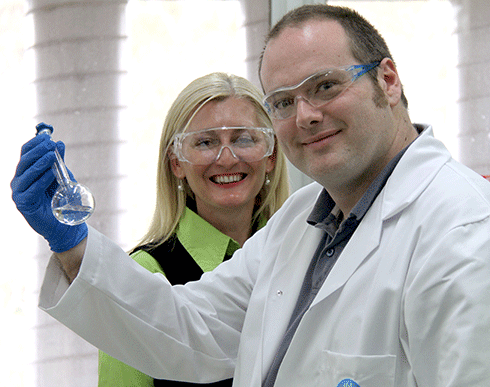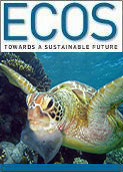
|
Published: 5 August 2013
Barrier reef corals deliver world-first for sunscreen
CSIRO, in partnership with skincare company Larissa Bright Australia, has created the world's first UVA/UVB sunscreen filters which mimic the natural sun protection used by corals on the Great Barrier Reef.

|
|
Larissa Bright and Dr Mark York in the lab with a flask of the UV filters. Credit:
CSIRO
|
The breakthrough paves the way for a new generation of sunscreens which harness the same protective barriers developed by Australia's Great Barrier Reef corals over millions of years to survive in the harsh Australian sun.
The new UV filters are resistant to both UVA and UVB rays and are clear and colourless which means they can be used in any cream emulsion.
CSIRO scientists have spent the last two years adapting the coral's sunscreen code so that it can be safely used as an ingredient in human sunscreen. The coral's sunscreen was improved to create a suite of 48 new sunscreen filters.
The scientists spent the last two years adapting the coral's sunscreen code so that it can be safely used as an ingredient in human sunscreen.
This research builds on work by scientists at the Australian Institute of Marine Science (AIMS) who were the first to discover the natural sun screening ability of coral on the Great Barrier Reef.
Larissa Bright Australia, in partnership with AIMS, studied the results of over 20 years of AIMS research into how shallow-water corals protect themselves from UV light before approaching CSIRO.
‘We wanted to find a way to convert this natural method of coping with exposure to the intensive UV rays from Queensland's sunshine, into a safe and effective sunscreen for human use,’ Larissa Bright, Company Director of Larissa Bright Australia said.
‘We feel these filters will set a new standard in broad spectrum sunscreen. They mimic the natural sunscreen coral has developed and used over millions of years.’ she adds.
CSIRO Research Scientist Dr Mark York, who led the research project in conjunction with Senior Research Scientist Dr Jack Ryan, said: ‘The molecular make up of the coral's natural sunscreen filter was quite complex, but the real challenge was modifying it so that it was resistant to both UVA and UVB radiation in one molecule which is what makes these filters so unique.
‘The filters are clear in colour, virtually odourless and very stable which makes them easy to be incorporated into any emulsion,’ he adds.
AIMS Research Director Dr Jamie Oliver is very pleased to see their research used as the foundation for this exciting development. ‘This is another example of AIMS researchers providing the science to underpin the use of Australia's tropical marine resources in an innovative and beneficial manner,’ he said.
The broad spectrum coral sunscreen filters are expected to be available to consumers across the globe within five years.
Source: CSIRO



